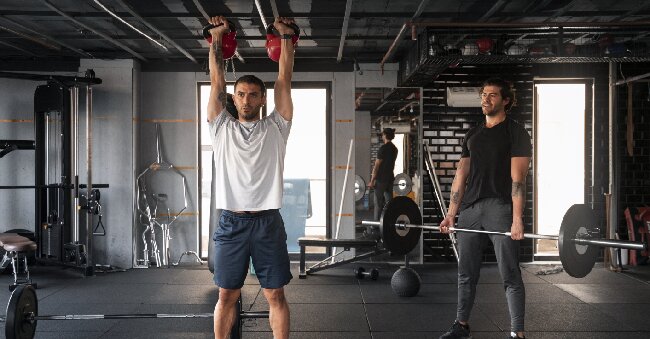
Unlock Your Fitness: 7 Key Benefits of Kettlebell Training and Essential Tips for Beginners
Are you looking to spice up your fitness routine and take your workouts to the next level?
Discover the benefits of kettlebell training, different types of exercises you can do, the equipment you need, how to choose the right kettlebell weight, proper techniques, common mistakes to avoid, frequency of training, and tips for incorporating kettlebell workouts into your fitness routine.
Unlock your fitness potential with kettlebell training!
What Is Kettlebell Training?
Kettlebell training is a dynamic and effective form of exercise that combines strength training, cardiovascular conditioning, and functional movements using a kettlebell, a cast-iron weight shaped like a ball with a handle. This versatile tool allows individuals to work on various muscle groups and movement patterns in a single workout session, promoting overall health and wellness.
Originating from Russia in the 1700s, kettlebell training was initially used by strongmen and military personnel to build strength and endurance. Over time, it evolved into a popular fitness regimen due to its ability to engage multiple muscle groups simultaneously, enhancing both strength and cardiovascular fitness.
The nature of kettlebell exercises, such as swings, snatches, and Turkish get-ups, challenges not only muscles but also improves coordination, flexibility, and balance. This holistic approach to training results in functional strength that translates into improved daily activities and reduced risk of injuries.
Why Is Kettlebell Training Effective?
Kettlebell training is highly effective due to its ability to engage multiple muscle groups simultaneously, enhancing strength, cardiovascular fitness, balance, and coordination. The dynamic nature of kettlebell exercises challenges the body in various planes of movement, leading to improved functional fitness and overall performance.
This form of training not only builds strength but also improves cardiovascular health, making it a comprehensive workout option for individuals seeking overall health and fitness benefits. By incorporating kettlebell routines into your exercise regimen, you can effectively increase your heart rate, promote fat loss, and boost your endurance levels. The focus required to perform kettlebell movements properly enhances mental concentration and coordination, contributing to a well-rounded approach to physical well-being.
Full-Body Workout
Engaging in kettlebell training provides a comprehensive full-body workout that targets major muscle groups, including the core, back, legs, and arms. This form of exercise improves strength, conditioning, and mobility, making it an ideal choice for individuals looking to enhance their overall fitness levels.
Incorporating kettlebell swings not only strengthens the hamstrings and glutes but also engages the core muscles for stability and power.
Exercises like kettlebell goblet squats work the quads and glutes while enhancing overall lower body strength.
Kettlebell renegade rows are effective for building upper body strength and stability, targeting the back and arms.
These dynamic movements, combined with proper form and control, promote functional strength, improved cardiovascular endurance, and enhanced coordination.
Builds Strength and Muscle
One of the key benefits of kettlebell training is its ability to build strength and muscle mass effectively. By incorporating compound movements and functional exercises, kettlebell workouts challenge the body to develop power, core strength, and overall muscle endurance.
Kettlebells offer a unique way to engage multiple muscle groups simultaneously, leading to balanced muscle development. The dynamic movements performed with kettlebells also improve stability and coordination, crucial for overall fitness.
Emphasizing proper form is essential to prevent injuries and maximize results. Focusing on technique ensures that the correct muscles are being targeted and reduces the risk of strain. Consistency in training with kettlebells can result in noticeable gains in strength and muscle definition, making it a valuable addition to any fitness routine.
Improves Cardiovascular Health
Kettlebell training is an effective way to improve cardiovascular health by elevating heart rate, enhancing endurance, and boosting stamina. The combination of strength and cardio elements in kettlebell exercises promotes overall cardiovascular conditioning and heart health.
The dynamic nature of kettlebell workouts, such as kettlebell swings, snatches, and cleans, engages the entire body, providing a holistic approach to cardiovascular fitness. These multi-joint movements activate large muscle groups, leading to increased oxygen consumption and improved circulation. By incorporating high-intensity interval training (HIIT) techniques with kettlebells, individuals can optimize their cardiovascular system, strengthen the heart muscle, and enhance their aerobic capacity. Consistent practice of kettlebell exercises can lead to significant improvements in lung function, endurance levels, and overall cardiovascular performance.
Enhances Balance and Coordination
Kettlebell training enhances balance and coordination through dynamic movements that challenge stability and body control. By incorporating exercises that require focus on proper technique and alignment, individuals can improve their overall balance, coordination, and mind-body connection.
This type of training not only helps in developing physical strength but also plays a vital role in enhancing proprioception, which is the body’s ability to sense its position in space.
Engaging the core muscles during kettlebell exercises is crucial for stabilizing the body and promoting better balance. Movements like the single-leg deadlift or Turkish get-up are fantastic for targeting balance and coordination as they challenge the participant to maintain proper form and alignment throughout the exercise.
It’s all about engaging the entire body in a coordinated effort to execute the movements effectively.
What Are the Different Types of Kettlebell Exercises?
Kettlebell exercises encompass a variety of movements, including swings, cleans, presses, snatches, and Turkish get-ups, each targeting different muscle groups and movement patterns. These exercises offer a dynamic and engaging way to improve strength, flexibility, and overall fitness.
Swings, for instance, are excellent for developing power and strength in the hips, glutes, and hamstrings. When performing swings, focus on hinging at the hips and driving the kettlebell explosively forward with your core engaged.
Cleans target the muscles in your back, shoulders, and arms, enhancing upper body strength and stability. Proper technique is crucial for cleans to prevent injury and maximize effectiveness.
Presses work the shoulders and triceps, helping to build pushing strength and shoulder stability.
Snatches are a full-body exercise that engages the legs, core, and shoulders, promoting coordination and power.
Turkish get-ups, on the other hand, require a combination of strength, balance, and coordination as you move through each step of the exercise, benefiting multiple muscle groups simultaneously.
Swings
Swings are a fundamental kettlebell exercise that targets the posterior chain, including the glutes, hamstrings, and lower back. This dynamic movement emphasizes hip power, muscle engagement, and proper form to maximize the benefits of the exercise.
By mastering the technique of kettlebell swings, one can effectively build strength, improve power generation, and enhance overall fitness levels. Engaging the hips to generate force and maintaining a strong core are essential components in executing swings correctly. The explosive nature of this exercise not only aids in muscle development but also contributes to improved agility and cardiovascular endurance. Consistent practice of kettlebell swings can lead to enhanced athletic performance and functional strength for daily activities.
Cleans
Cleans are dynamic kettlebell exercises that involve explosive movements to transition the weight from the floor to the racked position. This exercise challenges power generation, core strength, and overall movement coordination.
The explosive nature of kettlebell cleans not only aids in developing strength but also enhances cardiovascular endurance. By executing efficient cleans, individuals engage the muscles in a coordinated fashion, promoting balance and stability. This exercise is particularly effective in targeting the posterior chain, including the hamstrings, glutes, and back muscles. The fluid motion of cleans also improves grip strength and enhances proprioception, leading to better overall athletic performance and injury prevention.
Presses
Kettlebell presses target the shoulder and arm muscles while promoting stability and strength in the upper body. This exercise helps improve shoulder mobility, arm strength, and overall stability through controlled movements.
By incorporating kettlebell presses into your workout routine, you can effectively engage your deltoids, triceps, and upper back muscles. The pressing motion not only helps in building muscle mass but also enhances coordination and balance.
Proper form is crucial when performing kettlebell presses to prevent injuries and maximize results. It is essential to maintain a strong core and upright posture throughout the movement to ensure proper alignment and engagement of the targeted muscles.
Consistency in practicing kettlebell presses can lead to increased upper body strength and stability, making everyday tasks easier to perform.
Snatches
Snatches are dynamic and explosive kettlebell exercises that combine power, speed, and technique to raise the weight overhead in a single fluid motion. This exercise enhances explosive power, grip strength, and cardiovascular endurance.
By engaging multiple muscle groups simultaneously, kettlebell snatches effectively develop full-body coordination and stability. The swift and forceful movement required in snatches not only builds muscle but also boosts overall agility and reflexes.
As a full-body workout, snatches improve core strength, shoulder stability, and lower-body power. Regular practice of kettlebell snatches can result in enhanced neuromuscular activation, leading to increased athletic performance and injury prevention.
Incorporating snatches into your training regimen can significantly elevate your physical capabilities and overall fitness level.
Turkish Get-Ups
Turkish get-ups are complex kettlebell exercises that challenge stability, core strength, and full-body mobility through a series of controlled movements from lying down to standing up. This exercise promotes functional strength, balance, and mind-body connection.
Throughout a Turkish get-up, the body undergoes intricate movements that demand focus, coordination, and muscle control. By engaging various muscle groups simultaneously, such as the shoulders, core, legs, and glutes, individuals enhance their overall strength and endurance.
The deliberate pace of a get-up encourages mindfulness and concentration, fostering a deep connection between the mind and body. This exercise is not just about physical fitness; it is also about mental clarity and body awareness. The continuous practice of kettlebell Turkish get-ups can lead to improved stability, enhanced core engagement, and greater mobility in day-to-day activities.”
What Equipment Do You Need for Kettlebell Training?
The primary equipment required for kettlebell training is the kettlebell itself, available in various weights to suit different fitness levels and goals. Comfortable workout attire and proper footwear are essential to ensure safety and performance during kettlebell workouts.
When choosing a kettlebell for your workout, it’s crucial to select the proper weight to challenge your muscles without risking injury. Beginners may start with lighter weights to master form and technique before progressing to heavier ones.
Proper workout attire, such as moisture-wicking clothing, allows for freedom of movement and sweat management. Wearing supportive footwear with good traction helps maintain stability and balance while performing dynamic kettlebell exercises.
The combination of the right kettlebell weight and suitable workout gear enhances the effectiveness and safety of your kettlebell training sessions.
How Do You Choose the Right Kettlebell Weight?
Choosing the right kettlebell weight is crucial for a safe and effective workout. Beginners should start with a lighter weight to focus on mastering technique and gradually progress to heavier weights as they build strength and confidence in their training.
As one advances in their kettlebell training, it’s important to consider their individual fitness level and objectives to determine the appropriate weight selection. For those who are new to kettlebell exercises, opting for a weight that allows for proper form without compromising safety is key.
Progress should be gradual, increasing the weight incrementally rather than making drastic jumps. Listening to the body and being mindful of any signs of strain or discomfort is essential during these progressions. By taking a measured approach to weight selection, individuals can maximize the benefits of their kettlebell workouts while minimizing the risk of injury.
How Do You Properly Perform Kettlebell Exercises?
Proper form and technique are essential for maximizing the benefits of kettlebell exercises while minimizing the risk of injury. Focus on maintaining a neutral spine, engaging the core muscles, and coordinating proper breathing to ensure safe and effective performance throughout the workout.
When performing kettlebell swings, remember to hinge at the hips, keeping the back straight and driving the movement with the power of your hips. This ensures proper engagement of the glutes and hamstrings while protecting the lower back.
Maintaining a stable shoulder position during kettlebell presses is crucial; avoid shrugging your shoulders and focus on pushing the weight overhead using controlled movements to engage the deltoids and triceps effectively.
For squats and lunges, maintain alignment by keeping the knees in line with the toes, and engage the core to stabilize the body throughout the movement.
Warm-Up and Stretching
Prior to starting kettlebell exercises, it is crucial to perform a thorough warm-up routine that includes dynamic movements, stretches, and mobility exercises to prepare the body for the workout. Similarly, a proper cool-down session is essential to aid in muscle recovery and prevent injury.
Dynamic movements like arm circles, leg swings, and torso twists help increase blood flow and warm up the muscles, making them more pliable for the upcoming workout. Adding in dynamic stretches such as hip openers and shoulder rolls can improve flexibility and range of motion. Mobility exercises, like wrist circles and ankle rotations, target specific joints and areas to enhance overall movement patterns.
For the cool-down, incorporating static stretches for major muscle groups can help reduce muscle tension and improve flexibility, aiding in faster recovery.
Proper Form and Technique
Maintaining proper form and technique is paramount in kettlebell exercises to ensure muscle engagement, balance, and posture throughout the movements. Focus on alignment, muscle activation, and body awareness to maximize the effectiveness of each exercise and minimize the risk of injury.
By paying attention to the alignment of your body, you can ensure that your joints are properly positioned, reducing the strain on muscles and ligaments.
Engaging the core muscles is crucial for stability and power in kettlebell exercises, helping to protect the lower back and improve overall performance.
Maintaining body awareness allows you to make small adjustments during each movement, ensuring that you are getting the most out of the exercise and targeting the intended muscle groups efficiently.
Breathing Techniques
Effective breathing techniques play a crucial role in kettlebell exercises by enhancing performance, core stability, and endurance. Focus on coordinating breath with movement, utilizing diaphragmatic breathing, to optimize oxygen flow and energy output during workouts.
This synchronization of breath and movement is not just about inhaling and exhaling at the right times but also ensuring that the body receives a steady flow of oxygen to fuel the muscles and improve overall workout efficiency.
By practicing deep, controlled breathing, individuals can engage their diaphragm fully, allowing for better oxygen uptake and improved endurance.
Proper breathing techniques can also aid in maintaining core stability during kettlebell exercises, helping individuals to perform movements with greater control and strength.
What Are Some Common Mistakes to Avoid in Kettlebell Training?
In kettlebell training, it is important to avoid common mistakes that can compromise technique, increase the risk of injury, and hinder progress. Some common errors include using incorrect form, lifting too heavy weights prematurely, and neglecting proper progression in exercises.
These mistakes can lead to muscular imbalances, strains, and even more severe injuries over time if not addressed. To correct these errors, it is crucial to focus on maintaining a strong core, engaging the glutes during movements, and ensuring proper alignment throughout each exercise. It’s also recommended to start with lighter kettlebells to master the techniques before gradually progressing to heavier weights. By paying attention to form, safety, and progression, individuals can maximize the benefits of kettlebell training while minimizing the risks of injury.
How Often Should You Do Kettlebell Training?
The frequency of kettlebell training sessions depends on individual goals, fitness levels, and recovery capacity. Beginners may start with 2-3 sessions per week, gradually increasing frequency and intensity as they progress. Maintaining a balance between workouts, recovery, and progression is key to long-term success.
It’s essential for beginners to focus on mastering proper form and technique before moving on to heavier kettlebells. Starting with lighter weights allows for better muscle engagement and reduces the risk of injury.
As beginners advance, they can incorporate more complex movements and gradually challenge themselves with heavier kettlebells. Listening to the body’s signals and ensuring adequate rest between sessions is crucial to prevent burnout and promote muscle recovery. By gradually building strength and endurance, individuals can tailor their kettlebell training to align with their specific fitness goals and overall well-being.
What Are Some Tips for Incorporating Kettlebell Training into Your Fitness Routine?
Incorporating kettlebell training into your fitness routine requires setting clear goals, staying motivated, and tracking progress to ensure consistency and results. Start by defining your objectives, creating a structured workout plan, and gradually increasing the challenge to keep motivation high and maintain momentum.
To structure your kettlebell workouts effectively, consider incorporating a variety of exercises such as swings, presses, and Turkish get-ups. Mixing in different movements helps target various muscle groups and keeps your workouts engaging. It’s also important to focus on proper form to prevent injuries and maximize the effectiveness of each exercise.
Tracking your progress, whether through logging your sessions or keeping a workout journal, can help you stay accountable and motivated on your fitness journey.




No Comments